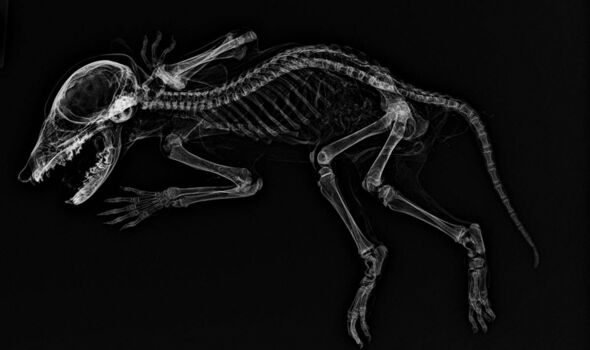

The mummy, dubbed the Capacabra, was found at Michigan State University in the US city of East Lansing, during renovations of Cook-Seevers Hall.
And though it's since become a mascot for the university's Campus Archaeology Program (CAP), the creature's true identity remains unknown.
Now PHD student Jerielle Cartales, who earned her master's degree at Scotland's University of Dundee, is working to solve the mystery.
She said: "It is roughly the size of a small cat, and it's got a very long, skinny tail, which goes hand in hand with cat-like features.
"But it has very, like, almost human hands. There's five fingers, and nails, and everything - it looks almost humanoid."It is covered with a very thin layer of tissue, but it is all super thin - it feels like old parchment paper.
"It has its nose and its ears still, but they're very dried out. "It's very dusty, dry, and weird."

The creature has been compared with the mythical chupacabra - a bloodsucking cryptid from American folklore. Hence the "capacabra" nickname, with its nod to the CAP initials.And just like its notorious namesake, the animal is shrouded in mystery.
Even its age is unknown at this point, though it can't predate 1889 - when the building was constructed."The creature is very mummified" said Ms Cartales, who studies forensic anthropology."So the interesting thing is that it could have been there for a month, it could have been there for 50 years, we don't really know.
"Theoretically, I guess we could try radiocarbon dating it, but the building itself isn't old enough for it to be worth it."
Theories about the animal's true identity have varied. After the remains were discovered in 2018, one expert tentatively suggested it could be an opossum.
"I didn't think so," said Jerielle."And so we were throwing out a bunch of ideas about what it could be."We were throwing out like 'maybe it's a dog, maybe it's a cat,' but raccoon didn't even make the list.
"And now, that's my very strong hunch."

The mummy has now been X-rayed and its skeleton compared with other known species. Using a textbook, leading candidates like dog, cat, and rat were quickly ruled out. Raccoon was a good match, but without a dental comparison it's hard to be sure.
Ms Cartales said: "A raccoon has the same general cranium shape, and the same with the snout shape.
"But the osteology text doesn't have any good images of dentition for the raccoon because their example was edentulous.
"So I'm trying to find an example of a raccoon I can use for dentition. That's the next step."
Jerielle thinks the creature may have entered the building through an air duct, got trapped, and become mummified over time.
She said: "Mummification happens in very dry environments."If it was found next to an air duct, which seems to me like the most accessible point for an animal to get in from the outside, then that would be a pretty regular supply of warm, dry air, especially in the colder months.

"So, to me, that's the most likely explanation.
"And then during the summer, it gets very hot here, and it's humid.
"But if you're protected by a building, and especially in some sort of duct system, then it really would just be dry, hot conditions, which is pretty perfect for mummification."
For now, Ms Cartales thinks a raccoon is a best candidate.She added: "I'm a scientist, I'm never going to say 100% on anything.
"I would say at this point, I'm about 75% sure that it's a raccoon, but I need to finish the rest of my analysis."